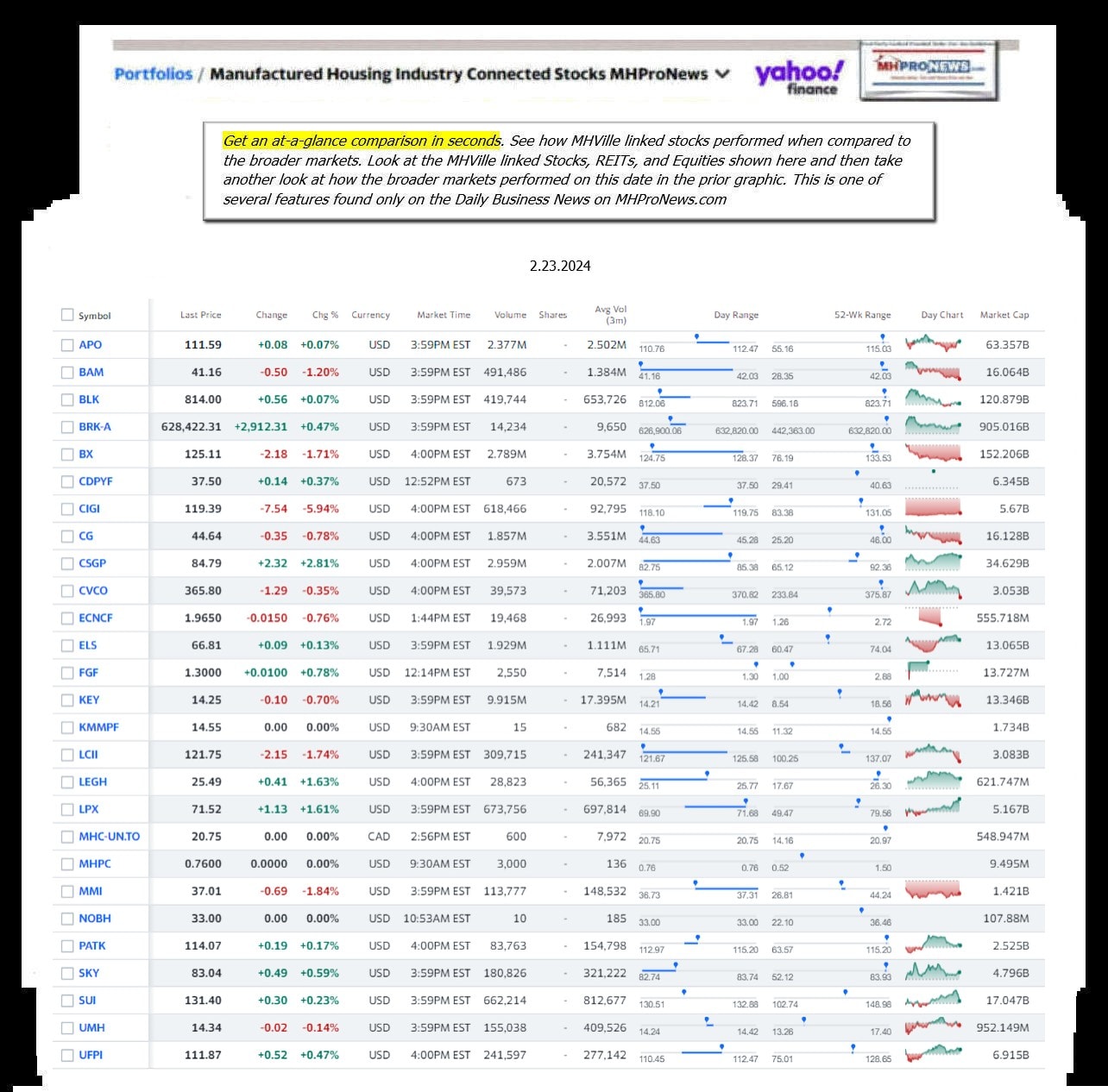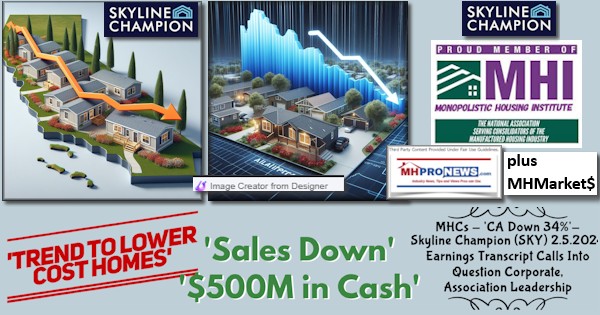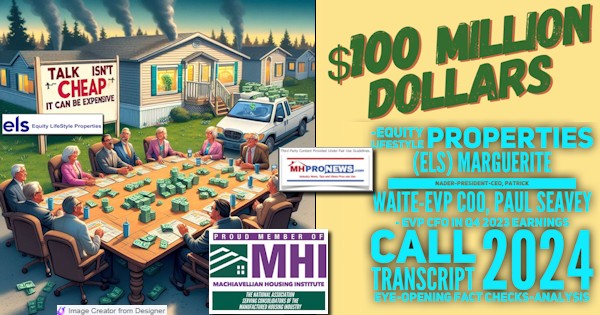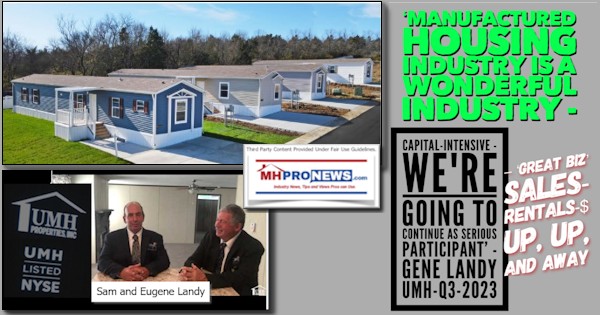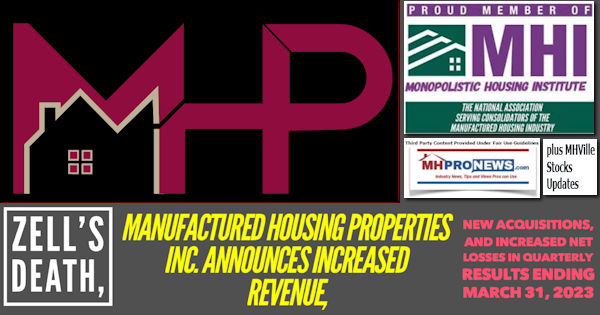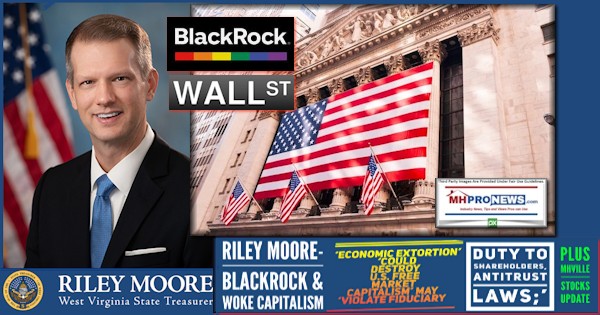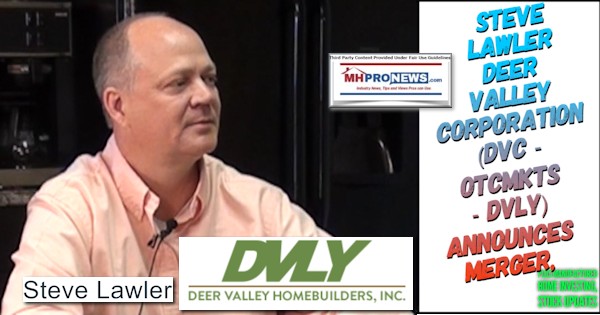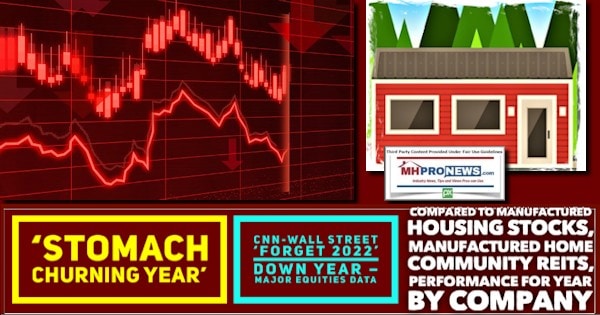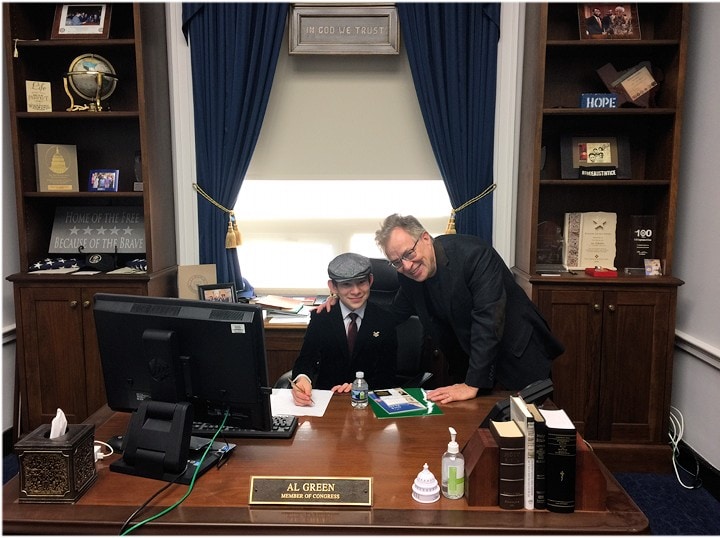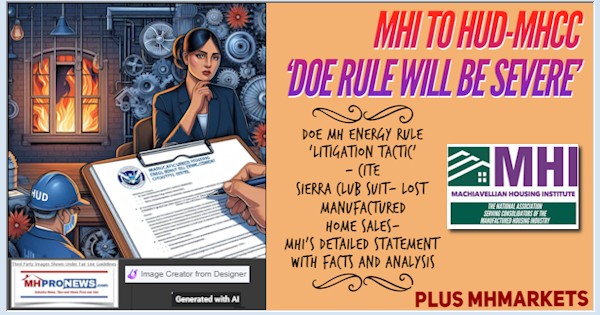
According to a letter on Manufactured Housing Institute (MHI) letterhead, the pending Department of Energy (DOE) energy rule for HUD Code manufactured homes “will be severe” in its impact on manufactured housing. The MHI letter, the complete text of which is provided below, accused the DOE of creating its planned “Enforcement Rule NOPR was promulgated as a litigation tactic rather than a meaningful and workable enforcement scheme.” MHI cited an estimated loss of tens of thousands of new manufactured home sales, which an initial review by MHProNews suggests may be an understatement. But the fact that MHI is arguing that thousands of new manufactured homes a year that would otherwise be sold will be lost if this DOE manufactured housing energy rule goes into effect is significant.
Among other points of interest in what follows in MHI’s letter is a reference to the Sierra Club litigation previously reported by MHProNews, as are several other items found therein.
MHI’s letter said: “In sum, the Energy Rule NOPR’s dearth of standards and certification undermines HUD’s enforcement and preemption program and exposes manufacturers to unnecessary liability.”
MHProNews obtained a copy of a the MHI letter about the pending DOE energy rule and enforcement standards addressed to Secretary Fudge signed by Lesli Gooch, Ph.D. Gooch is currently the CEO of MHI. She signed and sent this letter in advance of last week’s meeting of the Manufactured Housing Consensus Committee (MHCC), previously reported by MHProNews at this link here. As regular and detail minded readers of MHProNews may recall, Gooch has also been accused via a document drop (perhaps by a colleague at MHI) of conflicts of interests involving her working for the interests of conventional site-built housing.
According to an informed source, the letter signed by Gooch was likely written by MHI’s attorneys.
Based on an initial review by MHProNews, some of the remarks appear to be similar to those previously noted by the Washington, D.C. based Manufactured Housing Association for Regulatory Reform (MHARR), but some of the content that follows appears to be distinctive. It should be noted, for instance, that MHARR’s remarks on the numbers of Americans who will be barred from buying a new HUD Code manufactured home is stated in a more severe way than MHI’s letter does, even though what follows claims that the impact will be “severe.”
With the deadline for remarks to Regulations.gov for the pending manufactured housing approaching (2.26.2024), this report will present information from MHI and link related items from MHARR and other sources. Some significant omissions in what follows in Part I are noted in Part II. Part of MHI’s summary said: “This is an unworkable situation that will cause massive amounts of expense and uncertainty that will increase the cost of manufactured homes for consumers.” That is not so different in phrasing than the remarks by MHARR on 12.12.2023 that the pending DOE enforcement scheme for their manufactured housing energy rule is ‘stunning and unworkable.’
Part I – Contents of MHI’s letter on MHI letterhead
February 12, 2024
The Honorable Marcia Fudge
Secretary
U.S. Department of Housing and Urban Development 451 7th Street, S.W.
Washington, DC 20410
mhcc@homeinnovation.com
RE: Notice of Federal Advisory Committee Meetings: Manufactured Housing Consensus Committee (FR-6447-N-01)
Dear Secretary Fudge,
The Manufactured Housing Institute (MHI) is pleased to provide feedback to the Manufactured Housing Consensus Committee (MHCC) regarding the Notice of Federal Advisory Committee Meetings; Manufactured Housing Consensus Committee providing notice of the MHCC’s meetings scheduled forFebruary 15-16, 2024, to review and consider the Department of Energy (DOE) Notice of Proposed Rulemaking: Energy Conservation Program: Energy Conservation Standards for Manufactured Housing; Enforcement (the Enforcement Rule NOPR).
MHI is the only national trade association that represents every segment of the factory-built housing industry. Our members include builders, suppliers, retail sellers, lenders, installers, community owners, community managers, and others who serve our industry, as well as 50 affiliated state organizations. In 2022, our industry produced over 112,000 homes, accounting for approximately 12 percent of new single-family home starts. These homes are produced by 35 U.S. Corporations in 144 plants located across the country. MHI’s members are responsible for close to 85 percent of the manufactured homes produced each year.
The MHCC should recommend that HUD not adopt either the DOE’s Energy Efficiency Standards for Manufactured Housing (the Energy Rule) or the Enforcement Rule NOPR and instead undertake HUD’s standard rulemaking process, including consultation with the MHCC, to implement energy efficiency standards tailored to the manufactured housing industry to be enforced pursuant to HUD’s longstanding processes under the Manufactured Housing Construction Safety Standards (MHCSS). Specifically, the MHCC should request that HUD adopt into the MHCSS the superior energy standards recommended by the MHCC in the fall of 2022, with the enforcement of these standards through the longstanding HUD regime at 24 C.F.R. § 3282. The MHCC should also request that DOE withdraw the Enforcement Rule NOPR, as it would harm consumers and undermine HUD’s 50-year exclusive jurisdiction and enforcement over manufactured housing construction and safety standards, including energy efficiency, through the MHCSS.
As set forth herein, the Enforcement Rule NOPR was promulgated as a litigation tactic rather than a meaningful and workable enforcement scheme. Despite DOE’s suggestion to the contrary, the Enforcement Rule NOPR will increase costs of manufactured housing while simultaneously failing to provide any workable standards from which compliance with the Energy Rule can be measured. The Enforcement Rule NOPR undermines HUD’s enforcement program and preemption over manufactured housing. Moreover, the Enforcement Rule NOPR exposes manufacturers to excessive civil penalties that cannot be calculated with any reasonable certainty. To ensure workable and uniform standards and enforcement for energy efficiency in manufactured housing, the MHCC should recommend that HUD not adopt either the Energy Rule or the Enforcement Rule NOPR and instead undertake HUD’s standard rulemaking process, including consultation with the MHCC, to implement energy efficiency standards tailored for the manufactured housing industry to be enforced pursuant to HUD’s longstanding processes under the MHCSS.
The result of the Energy Rule that will be made effective through the Enforcement Rule NOPR will be severe. Specifically, it will significantly increase the cost of a new manufactured home and will result in an estimated 50,000 fewer manufactured homeowners over the next decade. Relatedly, it will disqualify many borrowers from being able to obtain a loan under standard mortgage loan debt to income (DTI) requirements. In the end, the cost increase for manufactured homes will greatly exceed any actual energy savings under the Energy Rule.
- Like the Energy Rule, the Enforcement Rule NOPR Was Promulgated for Litigation Strategy.
In 2007, Congress required DOE to establish standards for energy efficiency in manufactured housing “not later than 4 years after December 19, 2007.” 42 U.S.C. § 17071(a). Over ten years later, when DOE had not yet established energy efficiency standards for manufactured housing, the Sierra Club sued DOE in the United States District Court for the District of Columbia in Civil Action No. 1:-17-cv-02700. Ultimately, DOE and the Sierra Club entered into a consent decree requiring DOE to establish energy efficiency standards by May 16, 2022.
On May 16, 2022, DOE issued its notice of final rulemaking for the Energy Rule. In its haste to comply with this litigation deadline, DOE failed to abide by its statutory mandate to consult with HUD in the rulemaking process. In its first proposed rule in 2016, DOE acknowledged that “[t]est procedures are necessary to provide for accurate, comprehensive information about energy characteristics of manufactured homes and provide for the subsequent enforcement of the standards.” 81 FR 78734. However, after the 2016 proposed rule was withdrawn and replaced in 2021, DOE stated that it “has not included test procedures or compliance and enforcement provisions in this SNOPR” and “does not intend to address test procedures or compliance and enforcement provisions in this rulemaking.” 86 FR 44756.
HUD convened the MHCC to meet on October 18-19, 2022 and November 15-16, 2022 to “propose recommended changes to the [MHCSS] that align with the [Energy Rule].” 87 FR 57712. Among other issues with the Energy Rule, the MHCC stated:
- HUD, by statute, is the body responsible for the development and enforcement of manufactured housing standards.
- The MHCC has reviewed the DOE [Energy Rule] and has determined DOE circumvented the standards development process prescribed in EISA which requires cost justification and consultation with HUD.
- The MHCC previously recommended that DOE include the substantial cost of testing, enforcement, and regulatory compliance in its costing analysis. The final rule did not consider these costs. . .
See MHCC Working Document Submitted to HUD attached hereto as Exhibit 1.
Given these fundamental flaws, the MHCC was not able to fully align the MHCSS and the Energy Rule, so it did not recommend wholesale adoption of the Energy Rule into the MHCSS. Rather, the MHCC recommended modifications to the MHCSS “based largely on the [Energy Rule]” but that “increase energy efficiency while maintaining affordability and consumer options.” Exhibit 1. The MHCC opined that “[t]he recommended changes implemented into the MHCSS allow for testing, enforcement, and regulatory compliance within HUD’s existing framework which helps minimize costs to manufacturers and ultimately consumers. However, there may still be a gap in enforcement between HUD’s final standards and DOE’s final rule, which may need to be resolved.” Exhibit 1.
The Energy Rule was initially set to become effective on May 31, 2023. On February 14, 2023, MHI filed a lawsuit against DOE in the United States District Court for the Western District of Texas, Civil Action No. 1:23-cv-00174 (the Litigation). See Litigation Complaint attached hereto as Exhibit 2. In the Litigation, MHI asserted that DOE’s failure to consider the costs associated with testing, compliance, and enforcement of the Energy Rule rendered its life-cycle cost calculation incomplete and inaccurate. Weeks later, on March 23, 2023, DOE published a Notice of Proposed Rulemaking to delay implementation of the Energy Rule until 60 days after creation of final enforcement standards for Tier 1 homes and until July 1, 2025 for Tier 2 homes. 88 FR 17745.
On December 26, 2023, DOE issued the Enforcement Rule NOPR. Hamstrung by its previous refusal to include the cost of testing, compliance, and enforcement in the Energy Rule, and contrary to the statements from its 2016 proposed rule which stressed the necessity of testing procedures, the Enforcement Rule NOPR stated it “is not proposing to require manufacturers to conduct any testing of manufactured homes, require manufactured homes to be inspected prior to sale to consumers, or require manufacturers (or any third-party agency) to certify compliance with DOE’s energy conservation standards.” 88 FR 88848. Rather, the Enforcement Rule NOPR purports to require manufacturers to maintain records required under the MHCSS and submit the same to DOE as evidence of compliance with the Energy Rule. The Enforcement Rule NOPR states that because “the documentation required to maintain by [] this proposed rule is already subject to separate, existing maintenance requirements imposed by HUD . . . this proposed rule would not impose any new, additional costs beyond those already required by separate requirements.” 88 FR 88848.
Because the Energy Rule failed to include any costs associated with testing, compliance, or enforcement in its life-cycle cost calculation, DOE had no choice but to create an enforcement program that it says would not impose additional costs. The Enforcement Rule NOPR’s reliance on HUD’s regulations and paperwork to ensure compliance with its Energy Rule is unusual at best. Moreover, the Enforcement Rule NOPR appoints the DOE’s Office of General Counsel as responsible for overseeing enforcement of energy efficiency standards in manufactured housing. 88 FR 88846. And, as set forth below, the Enforcement Rule NOPR will result in substantial costs, unworkable standards that undermine HUD’s enforcement program for manufactured housing, and exposure to vague and excessive civil penalties. All of these irregularities stem from DOE’s hurried rulemaking process aimed primarily at avoiding litigation rather than creating a meaningful and workable enforcement program for energy efficiency standards in manufactured housing.
- The Enforcement Rule Will Cause Substantial Cost Increases.
The Enforcement Rule NOPR states that because “the documentation required to maintain by [] this proposed rule is already subject to separate, existing maintenance requirements imposed by HUD . . . this proposed rule would not impose any new, additional costs beyond those already required by separate requirements.” 88 FR 88848-49. This is false. Currently, the MHCSS and the Energy Rule are not aligned. Even if the MHCSS and Energy Rule were brought into alignment, they would not remain aligned. DOE is required to update the Energy Rule within one year of the promulgation of the latest version of the International Energy Conservation Code (IECC), which occurs every three years. HUD does not have any similar mandate to update the MHCSS with regularity. HUD’s rulemaking tempo is a product of its consultation with the MHCC. As such, even if steps were taken to align the MHCSS and Energy Rule during the present IECC cycle, the two standards would be updated at different times resulting in prolonged periods of misalignment.
The Enforcement Rule NOPR requires manufacturers to provide to DOE their Design Approval Primary Inspection Agency (DAPIA) records required under 24 C.F.R. § 3282.203(g) and 24 C.F.R. § 3282.361(b)(4), approved quality assurance manual required under 24 C.F.R. § 3282.361(c)(3), records related to Sub-Part I determinations required under 24 C.F.R. § 3282.417, and records of on-site construction required under 24 C.F.R. § 3282.608. However, none of these records are designed to demonstrate compliance with the Energy Rule, which materially differs from the MHCSS. HUD cannot require manufacturers to build homes to the Energy Rule, so these records do not necessarily reflect compliance with the Energy Rule. The Enforcement Rule NOPR does not (and cannot) require manufacturers to change forms required under the MHCSS to reflect the Energy Rule.
Because HUD records do not reflect designs, inspections, and testing unique to the Energy Rule, manufacturers would have to change their quality assurance manuals, DAPIA designs, and Sub-Part I programs to conform to the Energy Rule. Most manufacturers keep 50 to 100 different home models in production at any given time, so these documents will have to be modified for each model. Thereafter, DAPIAs, IPIAs, HUD, State Administrative Agencies (SAAs), and the Institute for Building Technology and Safety (IBTS) would have to approve the changes and factory personnel must be retrained to the new designs, manuals, and programs. However, HUD cannot require DAPIAs, IPIAs, SAAs, or IBTS to undergo training on the Energy Rule or fund any training on the Energy Rule. Likewise, DOE cannot interfere with current contracts between manufacturers and DAPIAs and IPIAs required under MHCSS. 24 C.F.R. § 3282.202.
Simply stated, for the Enforcement Rule NOPR to have any meaning whatsoever, substantial expense must be incurred to change longstanding design and quality assurance documents tailored to the MHCSS for every manufactured home model in production. These costs must be borne by manufacturers and passed on to consumers. Without incurring these costs, the Enforcement Rule NOPR leaves manufacturers unequipped to demonstrate compliance with the Energy Rule.
- The Enforcement Rule NOPR Provides No Workable Standards and Undermines HUD’s Enforcement Scheme and Preemption.
The Enforcement Rule NOPR provides no guidance as to how DOE will interpret and apply documents required to be maintained under the MHCSS to determine compliance with the Energy Rule. It provides no standards, measurements, testing procedures, interpretive materials, or safe harbors. The Enforcement Rule NOPR has no provisions for testing and compliance, but rather is only an enforcement program through potential civil penalties. As set forth above, in their current form, MHCSS documents will not demonstrate compliance with the Energy Rule. Therefore, manufacturers will have to guess as to how DOE will determine compliance with the Energy Rule based on submission of MHCSS documents. This guesswork will continue all the way through the administrative law process set forth in the Enforcement Rule NOPR for civil penalties.
In contrast to the Enforcement Rule NOPR, 24 C.F.R. § 3282 sets forth robust testing, compliance, and enforcement provisions that result in every home bearing a HUD label certifying its compliance with the MHCSS. 24 C.F.R. § 3282 has multiple layers of inspections and quality assurance through HUD, IPIAs, SAAs, and IBTS. The HUD label provides manufacturers persuasive evidence of compliance with the MHCSS both in regulatory and civil litigation settings. Here again, the HUD label will not serve as a certification of compliance with the Energy Rule. The Enforcement Rule NOPR has no corresponding label or certification and it provides no objective methods by which to determine or challenge compliance. The Enforcement Rule NOPR’s lack of testing and compliance standards opens the door for subjective determinations of noncompliance with the Energy Rule. Where the Energy Rule and MHCSS overlap, this lack of certification undermines HUD’s enforcement and preemption. This, in turn, exposes manufacturers to administrative and civil liability based on a subjective determination of non-compliance.
In sum, the Energy Rule NOPR’s dearth of standards and certification undermines HUD’s enforcement and preemption program and exposes manufacturers to unnecessary liability.
- DOE Relies on a 1% Civil Penalty That is Arbitrary and Capricious.
The Enforcement Rule NOPR relies heavily on EISA’s civil penalty “in an amount not exceeding 1 percent of the manufacturer’s retail list price of the manufactured housing.” 42 U.S.C. § 17071(c). However, most manufacturers do not utilize a “manufacturer’s retail list price,” which is not a term of art in the manufactured housing industry. EISA appears to have taken this terminology from a Monroney Label for cars. But the retail price of manufactured homes are dependent on a number of factors such as transportation distance, site improvements, time in inventory, and financing. Therefore, manufacturers will not be able to anticipate what amount of civil penalty may be imposed for a purported violation of the Energy Rule. And as set forth above, manufacturers will have no safe harbors or objective criteria for complying with the Energy Rule or challenging a determination of non-compliance.
- Summary.
If the Enforcement Rule NOPR becomes final, a manufacturer’s avenue toward complying with the Energy Rule would be to (1) undergo substantial expense to modify their DAPIA designs, quality assurance documents, and Sub-Part I programs; (2) blindly hope that the DOE Office of General Counsel interprets and applies the Energy Rule the same way as the manufacturer; and (3) wait to appeal a civil penalty of up to 1% of a non-existent manufacturer’s retail list price. All a manufacturer will have to protect itself are documents demonstrating compliance with the MHCSS that is not currently aligned with the Energy Rule and will be updated at different times. This is an unworkable situation that will cause massive amounts of expense and uncertainty that will increase the cost of manufactured homes for consumers.
To ensure workable and uniform standards and enforcement for energy efficiency in manufactured housing, the MHCC should recommend that the Enforcement Rule NOPR be withdrawn. It should also recommend that HUD not adopt either the Energy Rule or the Enforcement Rule NOPR and instead undertake HUD’s standard rulemaking process, including consultation with the MHCC, to implement energy efficiency standards tailored for the manufactured housing industry to be enforced pursuant to HUD’s longstanding processes under the MHCSS. Specifically, the MHCC should request that HUD adopt into the MHCSS the superior energy standards recommended by the MHCC in the fall of 2022, with the enforcement of these standards through the longstanding HUD regime at 24 C.F.R. § 3282.
Sincerely,
Lesli Gooch, Ph.D.
Chief Executive Officer
Part II – Additional Information with More MHProNews Analysis and Commentary in Brief
1). In the report linked here, MHProNews quoted Copilot saying the following.

Stalwart Advocacy:
-
- Despite [manufactured housing industry] controversies, MHARR remains steadfast in its mission. Their commitment to regulatory reform and fair representation for smaller businesses persists.
- Weiss’s involvement in formulating policies and advancing industry interests underscores MHARR’s dedication to its members and the broader manufactured housing community. …”
2). In another new DOE energy rule focused report linked here, Copilot made the following observations.

3. Credibility Concerns:
- The MHI’s history of providing partial or misleading information to its members raises credibility concerns. …”
3). Another Q&A with Copilot that were part of a longer thread said the following.

The above was a refinement that linked sources to the following a previous reply by Copilot that neglected to include links to its statements.

- Dual Stance on Energy Rule:
- The MHI’s actions appear to be dual-sided when it comes to the DOE’s manufactured housing energy rule.
- On one hand, documents obtained by the Manufactured Housing Association for Regulatory Reform (MHARR) via FOIA requests reveal that the MHI attempted to negotiate with the DOE to enforce the energy rule.
- On the other hand, the MHI’s attorneys have expressed concerns about “irreparable harm” to the industry if the rule goes into effect.
- Contrasting Approaches:
- The contrast between the MHI’s approach and that of the gas industry is notable.
- While the gas industry swiftly filed a suit to stop a regulation they opposed, the MHI’s suit took months to launch and only after significant public pressure.
- Industry Consolidation:
- During the time the DOE regulation has been pending, some MHI producers (such as Skyline Champion and Cavco Industries) have consolidated the production sector of manufactured housing.
- Notably, these consolidated firms often had street retail centers, leading to retail consolidation as well.
- Samuel Strommen’s Allegations:
- Samuel Strommen’s legal research involving the MHI and the so-called big three producers represented on the Manufactured Housing board of directors raises concerns.
- The behavior inferred from the evidence aligns with Strommen’s allegations. …”
4). So, in brief, to rephrase Copilot’s artificial intelligence powered assessment of MHARR is that it has been faithful to its mission and has avoided the kinds of duplicity that MHI has apparently engaged in.
To learn more about these issues, see the following linked reports, which routinely will include Copilot’s AI powered review of known facts. Each article in turn includes additional linked information.
MHARR’s detailed views on the DOE energy rule and enforcement mechanism is linked below.
5). Anyone involved in manufactured housing who thinks that this pending enforcement mechanism and related manufactured housing energy rule won’t be disruptive is not paying close enough attention to what is being said. As MHI’s team phrased it in the letter above:
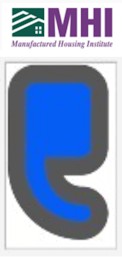
If the Enforcement Rule NOPR becomes final, a manufacturer’s avenue toward complying with the Energy Rule would be to (1) undergo substantial expense to modify their DAPIA designs, quality assurance documents, and Sub-Part I programs; (2) blindly hope that the DOE Office of General Counsel interprets and applies the Energy Rule the same way as the manufacturer; and (3) wait to appeal a civil penalty of up to 1% of a non-existent manufacturer’s retail list price. All a manufacturer will have to protect itself are documents demonstrating compliance with the MHCSS that is not currently aligned with the Energy Rule and will be updated at different times. This is an unworkable situation that will cause massive amounts of expense and uncertainty that will increase the cost of manufactured homes for consumers.”
What went unstated by MHI, but was not missed by Copilot, is that MHARR has provided documentary evidence they obtained from the DOE as well as a historic narrative that makes it clear that MHI has been on both sides of the fence.
While their letter mentioned the Sierra Club, it didn’t mention the funding ties that the Sierra Club has with Warren Buffett and others often aligned with him. MHProNews provided that information previously in the still relevant information found in the article linked below.
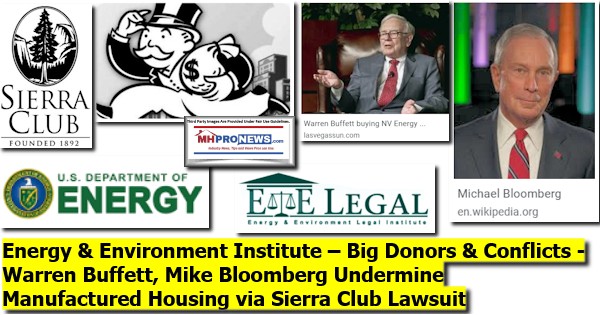
As was noted in the preface, MHI’s remarks often followed those of MHARR, and in some respects appear to mirror them. As Copilot recently noted, the significant difference in how the gas industry responded with swift litigation vs. the slow manner that MHI responded, and only after months of pressure from MHARR, MHProNews, and MHLivingNews are noteworthy.

6). The broader context of what is occurring in the manufactured housing industry, and thus the potential harm that MHI said the loss of tens of thousands of manufactured home sales from the current production levels, is informed by this next reports.
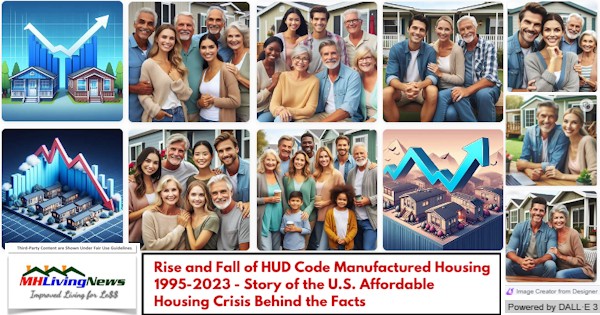
7). In summary, Copilot – which admitted it has a bias linked in part to Clayton Homes, which has obvious ties to MHI – said that MHI’s “dual stance” regarding the DOE energy rule. Specifically, Copilot observed:

- On one hand, documents obtained by the Manufactured Housing Association for Regulatory Reform (MHARR) via FOIA requests reveal that the MHI attempted to negotiate with the DOE to enforce the energy rule.
- On the other hand, the MHI’s attorneys have expressed concerns about “irreparable harm” to the industry if the rule goes into effect. …”
What Copilot called a: “Dual Stance on Energy Rule” also happened to coincide with”

-
- During the time the DOE regulation has been pending, some MHI producers (such as Skyline Champion and Cavco Industries) have consolidated the production sector of manufactured housing.
- Notably, these consolidated firms often had street retail centers, leading to retail consolidation as well.”
That in turn, said Copilot supports the various antitrust issues raised by legal researcher Samuel “Sam” Strommen. It also fits what has been dubbed “sabotaging monopoly” tactics explored by Minneapolis Federal Reserve economists, one of whom – James A. “Jim” Schmitz Jr. – said was leading to an oligopoly style monopolization of manufactured housing.
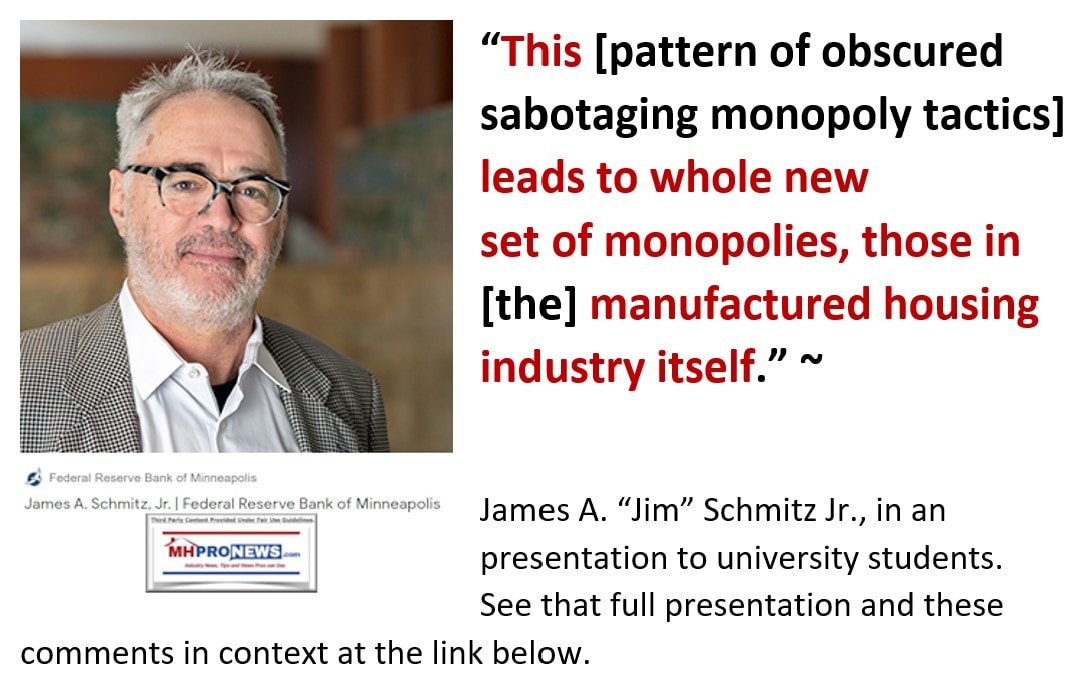
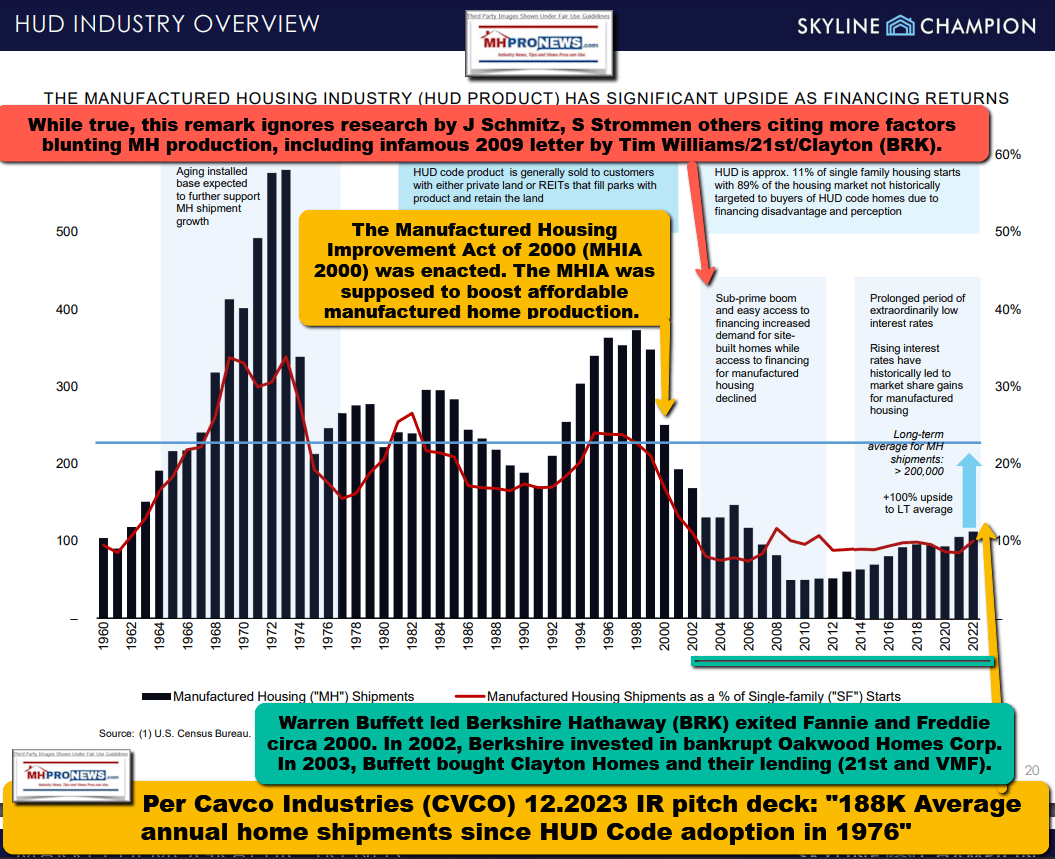
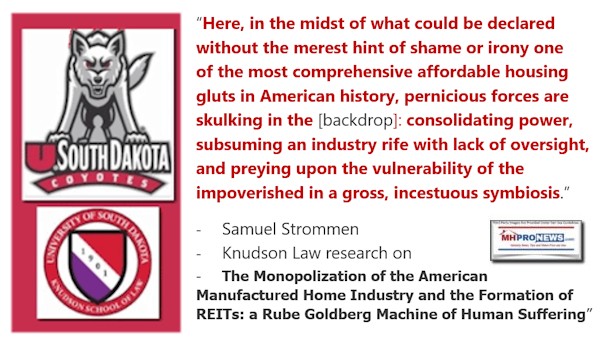
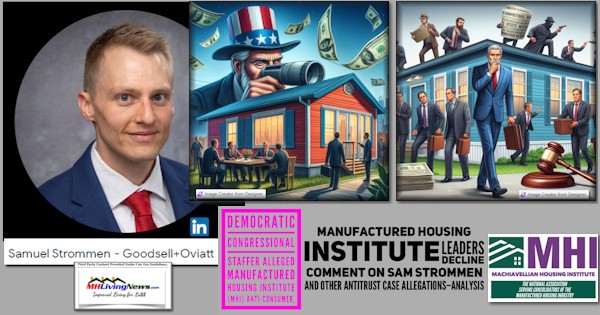
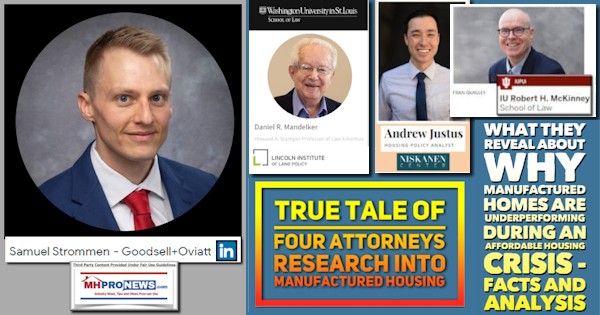
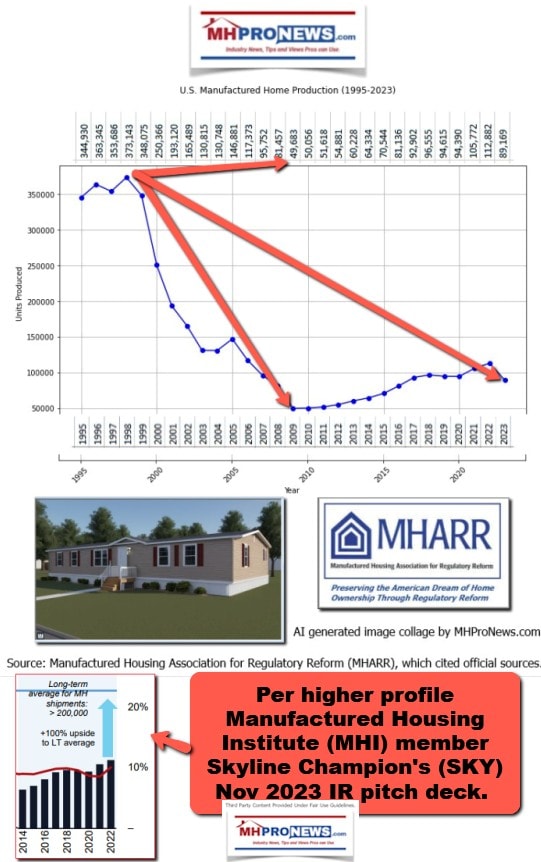
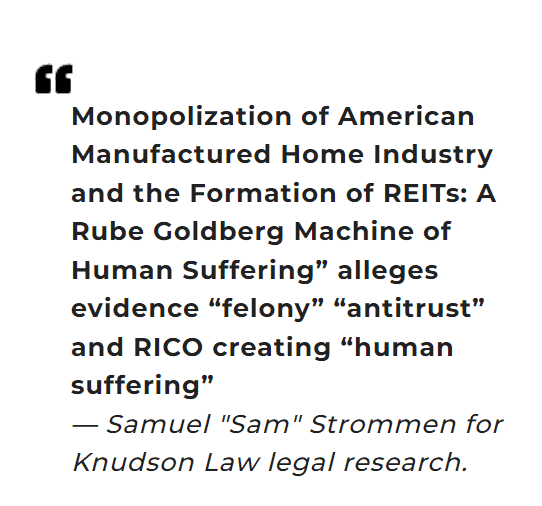
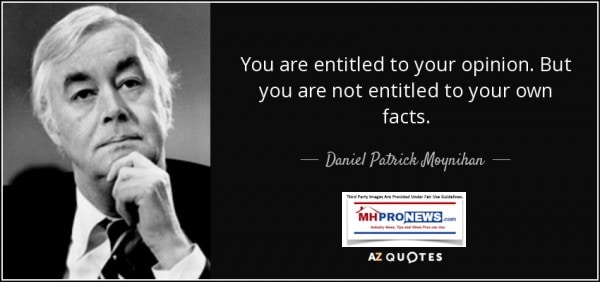
8). Programming Notes: Special Reports on Sun Communities, Flagship Communities, Clayton Homes/Warren Buffett/Berkshire Hathaway and more on the DOE Energy Rule are among the pending reports planned for the days ahead. Stay tuned for your most reliable source of in-depth information on the true state of the manufactured housing industry. It is all here on MHProNews and our MHLivingNews sister site where “Industry News, Tips, and Views Pros Can Use” © reigns because “We Provide, You Decide.” ©
Part III – is our Daily Business News on MHProNews stock market recap which features our business-daily at-a-glance update of over 2 dozen manufactured housing industry stocks.
This segment of the Daily Business News on MHProNews is the recap of yesterday evening’s market report, so that investors can see at glance the type of topics may have influenced other investors. Thus, our format includes our signature left (CNN Business) and right (Newsmax) ‘market moving’ headlines.
The macro market move graphics below provide context and comparisons for those invested in or tracking manufactured housing connected equities. Meaning, you can see ‘at a glance’ how manufactured housing connected firms do compared to other segments of the broader equities market.
In minutes a day readers can get a good sense of significant or major events while keeping up with the trends that are impacting manufactured housing connected investing.
Reminder: several of the graphics on MHProNews can be opened into a larger size. For instance: click the image and follow the prompts in your browser or device to OPEN In a New Window. Then, in several browsers/devices you can click the image and increase the size. Use the ‘x out’ (close window) escape or back key to return.
Headlines from left-of-center CNN Business – from 2.23.2024
- Why can’t we stop calling it Twitter?
- Cyberattack leaves patients facing the choice to pay – or wait for their prescriptions
- Gen Z and Millennials are putting their own spin on book clubs
- Reddit hasn’t turned a profit in nearly 20 years, but it just filed to go public anyway
- Nvidia processor and superchips are on display on stage at the COMPUTEX forum in Taipei, Taiwan May 29, 2023.
- Nvidia’s market value catapults to $2 trillion
- The United HealthCare Group Inc. logo on a laptop computer arranged in Hastings on Hudson, New York, U.S., on Saturday, Jan. 23, 2021. UnitedHealth Group Inc. recorded a smaller profit for the last quarter of 2020 as the company saw rising medical costs tied to Covid-19, the Washington Post reports. Photographer: Tiffany Hagler-Geard/Bloomberg via Getty Images
- Pharmacies across America are having trouble processing some prescriptions because of a cyberattack
- A Volkswagen Golf GTI car leaves the assembly line at the Volkswagen factory on March 8, 2018 in Wolfsburg, Germany.
- Volkswagen is recalling 260,000 small cars for fire risk
- A Warner Bros Discovery office in New York, US, on Saturday, Feb. 17, 2024.
- Warner Bros. Discovery posts a much narrower loss than a year ago
- Children at an education and childcare center in Des Moines, Iowa, U.S., on Feb. 9, 2022. Since Covid-19 arrived in earnest in early 2020, about one-third of childcare centers have closed and some 111,000 workers have departed the sector.
- Child care benefits at work: Employers are increasingly offering resources to parents with daycare needs
- A woman holding a cell phone walks past an AT&T retail store in New York, NY, February 22, 2024. AT&T customers have been affected by nationwide cellular outages as the company reports that it is working on the widespread cellular disruption.
- ‘I couldn’t work the whole day’: AT&T outage frustrates customers on the go
- Everyday investors are feeling good about the market again
- The hollowing out of Vice and BuzzFeed marks the end of the digital media revolution
- Florida House passes legislation that would prohibit kids under 16 from having certain social media accounts
- The Tesla Cybertruck is impressive and worrying
- Nvidia names Huawei a top competitor in major areas including AI chips
- AT&T says service has been restored after massive, nationwide outage. Authorities are investigating
- 5 things to know about the massive AT&T network outage
- Vice to lay off hundreds of staffers, stop publishing content on its website
- Fox News hyped the bogus FBI informant claims against Biden. Now it’s refusing to walk them back
- Toyota recalls 280,000 vehicles because they may ‘creep forward’ in neutral
- FTC fines cybersecurity company Avast $16.5 million for tracking and selling user data
- Could the Federal Reserve rule out rate cuts in 2024?
- Former journalist indicted for allegedly hacking and leaking embarrassing Fox News Tucker Carlson footage
